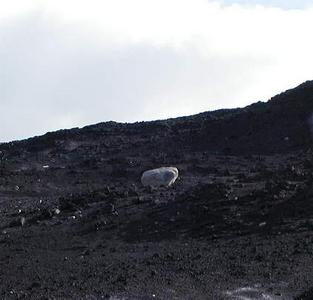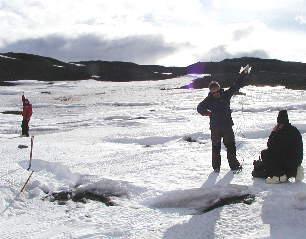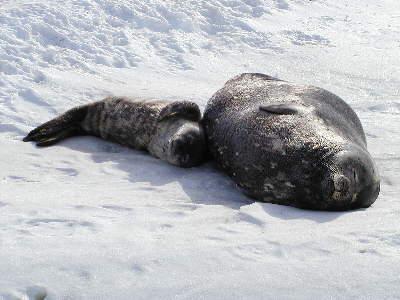26 November, 2003
A few more thoughts to add.
I could not let the events of the last few days go without mentioning a few more items. First, some of the strange things you see at first glance seem rather odd but upon further consideration, makes perfect sense. In today's journal, I have included a picture of a bleached-out starfish lying on the snowfield. It looks a bit odd at first glance, but when you step back and see the forces at work here, you could come up with a couple of mechanisms right off the bat that could lead to such a find. One possibility is the sea ice is quite active and could have plowed this little starfish up from the bottom, depositing it on the surface only to be covered and uncovered by snows. Another possibility has to do with the locals, a penguin, could have grabbed it off the sea bottom and dropped it on the snow and lost it or abandoned it. Can you think of any other situations that could have led to such a find?
The other item is the boulder of granite sitting in this field of weathered volcanic basalt and scoria, a small island of white in a sea of black. Again seemingly out of place but if you consider the glaciation this area is exposed to, it is no wonder that these rocks have been transported long distances, plowed up from the north and laid to rest on these volcanic islands as the ice retreated.
Another fact of life here in Antarctica, is the need for good communications. Often we will be out of range of the hand held VHF radios (They transmit on a similar frequency that police and fire scanners pick up.) and the associated repeaters (Automated radio transceivers placed at high elevations that rebroadcast your hand held radio transmissions to enable your signal to reach further.) This means we must use HF radio, which unlike the VHF, is not line of sight but uses the ability of certain radio frequencies to reflect off the Earth's ionosphere and "skip" greater distances and over mountains. However, these radios require long wire antennas since their wavelengths are tens of meters long and consequently a bit of setup. Ideally, you would set up a mast and end poles for the dipole antenna required for HF transmissions but since we were only there for a night we used a human mast and human end poles. Our signal was not the best since we were lacking in elevation but we did get through to McMurdo on 4.770mhz.
We did get to see just a wisp of the total solar eclipse. I have seen several including an annular in my life but it would have been grand to have seen one here in Antarctica. Alas, one forgets how big this continent is, so travel to the other side would have been nearly impossible. I have been told that some folks have put images shot from Antarctica up on the network "I" drive but it is not the same as seeing it for yourself so I will have to be content with the meager image I shot through the clouds from off shore of McMurdo Station.
The last image is that of a seal and her pup. We came upon this scene while at Cape Evans. We were careful not to disturb them and they seemed happy to lie there in the sun absorbing the solar radiation. The picture reminded me of that certain pleasure a parent can draw just by being next to their child knowing that they are safe and content with life. Which got me to thinking of how much I miss my family and how terrific it would be to share these experiences with them first hand. Yet what a wonderful world it is where we can communicate from far off reaches of the world instantly, sharing photos, voice and writings at will. As Bill Nye says "Not that bad!?"
Cheers,
Andy

A starfish found on the snowpack at Cape Royds

Boulder of granite in a basalt field.

Human HF antenna masts help communicate on HF to McMurdo.

Solar eclipse image taken through a band of clouds.

A cow and her pup enjoy the sun at Cape Evans.
Contact the TEA in the field at
.
If you cannot connect through your browser, copy the
TEA's e-mail address in the "To:" line of
your favorite e-mail package.
|
